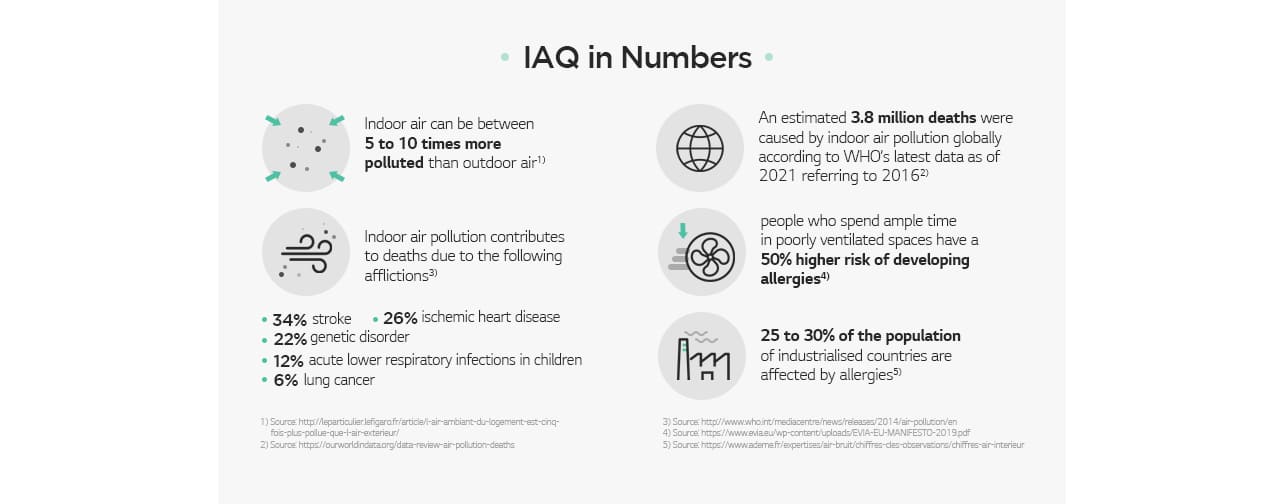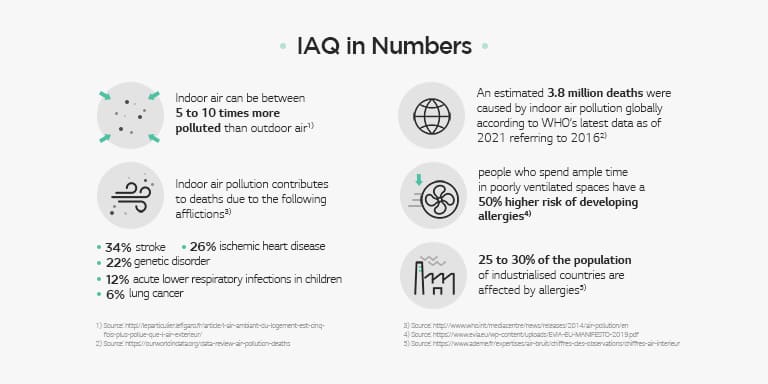-
IAQ: Why Is It So Crucial?
These days, most people are fairly well-acquainted with the idea of protecting the environment, and those who live in large cities are particularly weary of the effects of pollution and the need to restrict its harmful effects. A lesser recognized issue is that of indoor air pollution and the toll this takes on human health.
IAQ is concerned with improving upon the air within a building in which only now, are we realizing inherent toxic threat this invisible foe wields. Indoor air quality is now one of the most important factors when considering indoor environments across all spaces; from hospitals and nursing facilities, which are particularly susceptible to infection, to the more mundane places where we spend our daily lives, such as cafes, restaurants, and offices.


-
According to WHO’s latest data referring to 2016, indoor air pollution is one of the most significant risks to human health in coming years and claims the lives of a whopping 3.8million individuals each year1). They recognize the impending risk of indoor air quality as well and go on to state that some 3.8 million deaths a year could be due to poor indoor air quality - indicating a severeness over outdoor air quality and this type of damage has a myriad of consequences downstream including a burgeoning burden on the health care system.
Outdoor pollution that puts significant taxes on the quality of indoor air could be the usual culprits like smog or debris from construction sites, traffic jams as well as their organic counterparts like pollen and plant foliage.
1) who.int/news-room/fact-sheets/detail/household-air-pollution-and-health
-
While initially, not an entirely intuitive notion to grasp, it becomes more obvious with a little bit of contemplation; as indoor air quality is not only radically affected by external components that plague outdoor air quality, it is also subject to the factors inherent in the building materials, furniture, and living organisms coming into contact in close quarters. Indoor pollutants can stem from such things as poor building materials, faulty or denigrating home appliances and furniture, poorly installed or maintained electrical circuits, and mechanical devices, not to mention the threats from bodily fluids coming from occupants themselves.
-
Some additional sources of both indoor and outdoor pollutants could include the following*:
✓Fuel-burning combustion appliances
✓Tobacco products
✓Building materials and furnishings as diverse as:
Deteriorated asbestos-containing insulation, newly installed flooring, upholstery or carpet, cabinetry or furniture made of certain pressed wood products
✓Products for household cleaning and maintenance, personal care, or hobbies
✓Central heating and cooling systems and humidification devices
✓Excess moisture from cooking or washing facilities
✓Outdoor sources such as:
Radon, pesticides, or outdoor air pollution.
*Reference: https://www.epa.gov/indoor-air-quality-iaq/introduction-indoor-air-quality
-
Among various pollutions sources, viruses and germs and various particulate matter pose significant short, medium, and long-term risks to any humans, and the need for the appropriate management of these pollutant sources has been acknowledged by many these days.
Viruses spread through direct contact with bodily fluids and the air in the form of droplet particles. Experts say that well-designed airflow and ventilation in indoor spaces can play a significant role in mitigating the spread of airborne pathogens.
![Air flow Drag force Gravity Droplets are swept by the air motion and fall due to gravity. Their fall is resisted by a drag force Droplets evaporated to become droplet nuclei Turbulence mixing dilutes the droplet concentration Ballistic trajectory of large droplets from sneezing mode Droplets land on a surface and dries to become desiccated. Bed making activities can eject dry particles into the air 1-2 metres Dilution of contaminated air from breathing mode [Source : ASHRAE.org] Theoretical aerobiology of transmission of droplets and small airborne particles produced by an infected patient](/levant_en/business/images/tackling-indoor-air-quality-and-why-it-matters/H-A-HVACblog-Tackling_IAQ-2022_D03.jpg)
![Air flow Drag force Gravity Droplets are swept by the air motion and fall due to gravity. Their fall is resisted by a drag force Droplets evaporated to become droplet nuclei Turbulence mixing dilutes the droplet concentration Ballistic trajectory of large droplets from sneezing mode Droplets land on a surface and dries to become desiccated. Bed making activities can eject dry particles into the air 1-2 metres Dilution of contaminated air from breathing mode [Source : ASHRAE.org] Theoretical aerobiology of transmission of droplets and small airborne particles produced by an infected patient](/levant_en/business/images/tackling-indoor-air-quality-and-why-it-matters/H-A-HVACblog-Tackling_IAQ-2022_M03.jpg)
-
Before the concerns about airborne dissemination began, there were already growing calls to proactively deal with high PM, (particulate matter), in recent years – particularly in large urban sprawls. PM particles, due to their minuscule nature PM 2.5(2.5 micrometers or smaller) and 1.0(1.0 micrometers or smaller) can bypass cilia in the nose and throat and be absorbed easily into the lungs and bloodstream making them particularly harmful to humans and animals. Long-term exposure to PM is much more dangerous for children and those suffering from heart and lung disease – posing a real threat to the state of health of modern society.
-
HVAC and the Era of Pandemic
Since the COVID 19 outbreak, as IAQ has become one of the most important factors of HVAC regardless of the type of space, there have been major overhauls in HVAC products and solutions implemented industry-wide.
In the past, HVAC solutions focused primarily on providing comfort through heating and cooling. However, innovation is currently trending toward acknowledging the importance of ventilation, hygienic technology, and filtration solutions for health and hygiene.
When it comes to reducing the risk of infection - since pathogens can move freely by airflow, having an adequate amount of ventilation and purification enabled by our HVAC systems is extremely important. Significant efforts have been made to create vigilant systems that incorporate functions into our systems whereby the transmission of pathogens is reduced.
-
How Can IAQ Be Improved?
As with most problems, the path to overcoming barriers to optimal air quality is better attained by employing a multi-pronged approach.
As such we have outlined ventilation, air purification, hygienic technology, and temperature and humidity control are the four routes through which a higher degree of indoor air quality can be achieved. Used together, these strategies will equip your home, office, school, hospital, or retail shop with a sure-fire method of maintaining quality air.
-
▪ Ventilation
At its core, ventilation aims to remove CO2 and other gaseous pollutants that cannot be purified with an air purifier alone.
However, to reduce energy loss, modern construction technologies have been developed to improve upon airtightness. Unfortunately, this feature further stifles healthy air circulation thus increasing the need for a mechanical ventilation system even more.
As with any element of HVAC, the design of ventilation, whether as a standalone system or as part of a whole building solution, must meet the requirements of the occupants of a given building, and a range of models have been engineered to cater to the array of specifications. In particular, research has proven individual ventilation units targeting specific areas within a building are the best way to aid ventilation without increasing the risk of spreading pathogens.
The recirculation of air with AHUs and ducts allows infectious pathogens and pollutants to disseminate to other areas of a building. Therefore, ASHRAE and REHVA guidelines recommend HVAC systems be fit with personalized ventilation that provide local exhaust of contaminated zones to prevent the spread of infection. These systems avoid recirculation of air and deliver highly-filtered, fresh outdoor air to occupants indoors.
-
▪ Air Purification and Filtration
In addition to ventilation, IAQ can be improved through air filtration. For general occupants, it is recommended to improve the central air conditioning system and other HVAC filtration devices to a MERV-13(ASHRAE 2017b) or highest level achievable and to also add portable air cleaners with HEPA or high-MERV filters (AHAM 2015) * According to "ASHRAE Position Document on Infectious Aerosols", HEPA-grade filtration for local recirculation air is recommended for health care facilities. Appropriate maintenance is required for the optimized performance of the filters as time goes by. Small particulates like fine dust are invisible and difficult to recognize, so various sensing and control technologies are being developed for air quality visualization to improve upon this maintenance. Sensing and control technologies are often overlooked. However, these technologies are equally important in ensuring the quality of IAQ.
* Association of Home Appliance Manufacturers (US)
-
▪ Hygienic Technology
Yet another successful way to actively combat the problems of indoor air is to employ hygienic technology.


-
UVGI and Ionizer
Ultraviolet germicidal lights have been shown to effectively improve indoor air quality by removing microorganisms. Sunlight itself has long been used as a method to mitigate the growth of harmful bacteria, and this approach can be mimicked with the use of specialized UV systems. In fact, these types of UV systems have been incorporated for decades in the removal of microorganisms in hospitals, laboratories, and other places where hygiene air is a vital part of operations.
Furthermore, ionization can be another method applied to improve the filtration mechanism. The plasma ion emitted deactivates bacteria and viruses thus providing cleaner air within a given space. Active hydrogen and oxygen ions are released directly into the air to help reduce the impact of VOCs while active oxygen neutralizes toxic particles and generates H2O.
-
▪ Temperature and Humidity Control
Finally, proactively managing humidity within an indoor environment is crucial for improving the personal well-being of its occupants. Scientific evidence has illustrated that keeping air relative humidity between a 40 and 60% range has significant benefits on human health. At low humidity (10%-20%), the human body is vulnerable to infection. This humidity range is ideal to ensure the effectiveness of our innate immune defenses, like keeping mucous levels aptly viscous.
-
Particularly, given the current circumstances with the COVID pandemic, as well as being cognizant of future threats going forward, this is an extremely important aspect of system design to take into consideration. Even after the pandemic is over, IAQ will be no longer be an option but a necessity. LG HVAC is dead-serious about providing hygiene and clean indoor environments through its fine-tuned systems. In the upcoming next part of this series, we will discuss how LG will improve the indoor quality for better life quality.
LG has published a white paper on IAQ.
Click the button below and find out more about the industry’s IAQ trends and LG's IAQ solutions.


Please click the 'INQUIRY TO BUY' banner below to contact your local LG office for further information on solutions and products.






